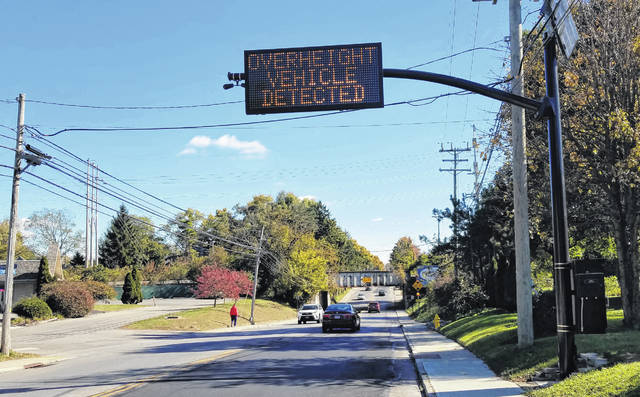
Delaware’s infamous West Central Avenue railway overpass, more commonly known as the “Can Opener,” has collected many victims through the years. Oblivious to the warning signage, drivers of vehicles without the necessary height clearance have unwittingly taken on the overpass, always resulting in an all-out mess for the driver, the city and local residents.
Looking for ways to remedy the increasingly problematic overpass, raising the bridge or lowering the pavement below the bridge had been talked about through the years. However, due to a bevy of issues those projects would cause — most notably the price tag — the city ultimately opted to go with a more practical response.
In 2018, city crews installed large, black message boards displaying warning messages on both sides of the road. The message boards work in conjunction with a laser-guided over-height detection system that was put into operation just before the installation of the signs.
The sensors are located approximately 900 feet before each bridge entrance, with the eastbound beam installed near the entrance to OhioHealth Grady Memorial Hospital and the westbound beam near Euclid Avenue. If a vehicle trips the laser sensors, the message board on that side of the bridge will first flash “WARNING” before displaying “OVERHEIGHT VEHICLE DETECTED.”
When activated, the signs flash back and forth between the two messages every two seconds over the span of three minutes. If not activated, the signs remain black.
Funding for the project was provided by the state, with city staff providing some of the work to install the system. In total, the installation was completed under budget for $165,000.
“Reducing the number of bridge incidents — even a small amount — allows the police department to focus on other duties in and around the city,” Delaware Community Affairs Coordinator Lee Yoakum told The Gazette in 2018. “It is important to note that other city departments are impacted when the bridge is hit. Public Works Department staff are often called in to help maintain traffic flow and with cleanup. The cost to the city each time the bridge is struck can run $2,000 to $3,000 for manpower and equipment.”
Yoakum said in 2018 that the technology the city is utilizing is also used in several other states. After speaking with officials in those states — New York, Texas and Virginia — city officials believed the new detection system would “reduce bridge incidents by 50 to 60%,” he said.
Three main objectives were highlighted with the installation of the detection system; getting drivers to turn around, preventing high-speed impacts that destroyed trailers; and reducing the city’s efforts and cost in incident cleanups.
Over the span of nearly three years prior to the installation of the message boards and laser sensors, the Can Opener had claimed nearly 20 victims. Since the installation of the system in late 2018, there have been just 12 accidents involving vehicles striking the overpass, according to the city. Of the 12 incidents from 2019 to the present day, only two accidents have required assistance with debris cleanup and flagging traffic.
Statistics accumulated by the city show 60 documented instances over the past 12 months where vehicles tripped the laser system but stopped short of striking the bridge. Yoakum said the success rate at stopping bridge strikes is likely even higher as the documented total only counts occurrences recorded by city staff during daytime work hours.
The fine for ignoring warnings and hitting the bridge is $1,000, while the fine for ignoring warnings and needing help in getting a trailer turned around is $750.
While the detection system has proven to be effective, the reality is the headaches involving the overpass will never be alleviated entirely until drivers begin to pay better attention.
“Inattentive drivers are the problem, and until that variable can be eliminated, things like this, unfortunately, will continue to happen,” Yoakum told The Gazette. “But the warning system has been a positive addition and provided relief for residents, public safety personnel, and the community as a whole.”
Yoakum went on to say, “The ultimate solution is for inattentive drivers of vehicles taller than the posted bridge height to read the signs and obey the warnings. In our mind that is not that difficult.”


